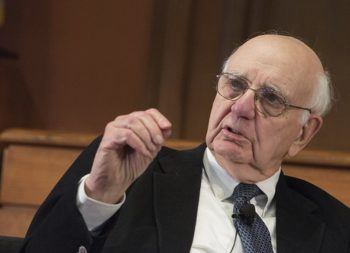Tim Barker in n + 1:
 IF SOMEONE WERE TO MAKE a movie about neoliberalism, there would need to be a starring role for the character of Paul Volcker. As chair of the Federal Reserve from 1979 to 1987, Volcker was the most powerful central banker in the world. These were the years when the industrial workers movement was defeated in the United States and United Kingdom, and third world debt crises exploded. Both of these owe something to Volcker. On October 6, 1979, after an unscheduled meeting of the Fed’s Open Market Committee, Volcker announced that he would start limiting the growth of the nation’s money supply. This would be accomplished by limiting the growth of bank reserves, which the Fed influenced by buying and selling government securities to member banks. As money became more scarce, banks would raise interest rates, limiting the amount of liquidity available in the overall economy. Though the interest rates were a result of Fed policy, the money supply target let Volcker avoid the politically explosive appearance of directly raising rates himself. The experiment—known as the Volcker Shock—lasted until 1982, inducing what remains the worst unemployment since the Great Depression and finally ending the inflation that had troubled the world economy since the late 1960s. To catalog all the results of the Volcker Shock—shuttered factories, broken unions, dizzying financialization—is to describe the whirlwind we are still reaping in 2019.
IF SOMEONE WERE TO MAKE a movie about neoliberalism, there would need to be a starring role for the character of Paul Volcker. As chair of the Federal Reserve from 1979 to 1987, Volcker was the most powerful central banker in the world. These were the years when the industrial workers movement was defeated in the United States and United Kingdom, and third world debt crises exploded. Both of these owe something to Volcker. On October 6, 1979, after an unscheduled meeting of the Fed’s Open Market Committee, Volcker announced that he would start limiting the growth of the nation’s money supply. This would be accomplished by limiting the growth of bank reserves, which the Fed influenced by buying and selling government securities to member banks. As money became more scarce, banks would raise interest rates, limiting the amount of liquidity available in the overall economy. Though the interest rates were a result of Fed policy, the money supply target let Volcker avoid the politically explosive appearance of directly raising rates himself. The experiment—known as the Volcker Shock—lasted until 1982, inducing what remains the worst unemployment since the Great Depression and finally ending the inflation that had troubled the world economy since the late 1960s. To catalog all the results of the Volcker Shock—shuttered factories, broken unions, dizzying financialization—is to describe the whirlwind we are still reaping in 2019.
More here.
